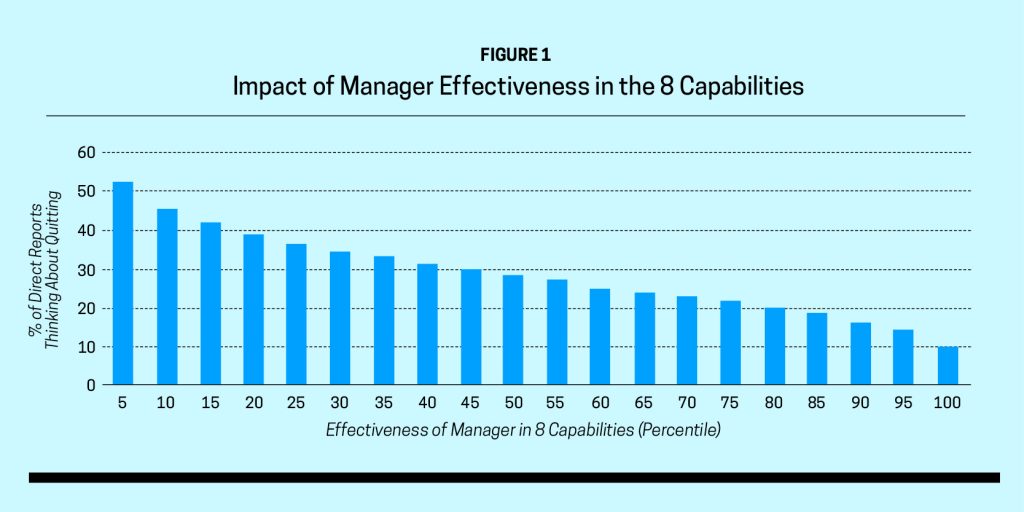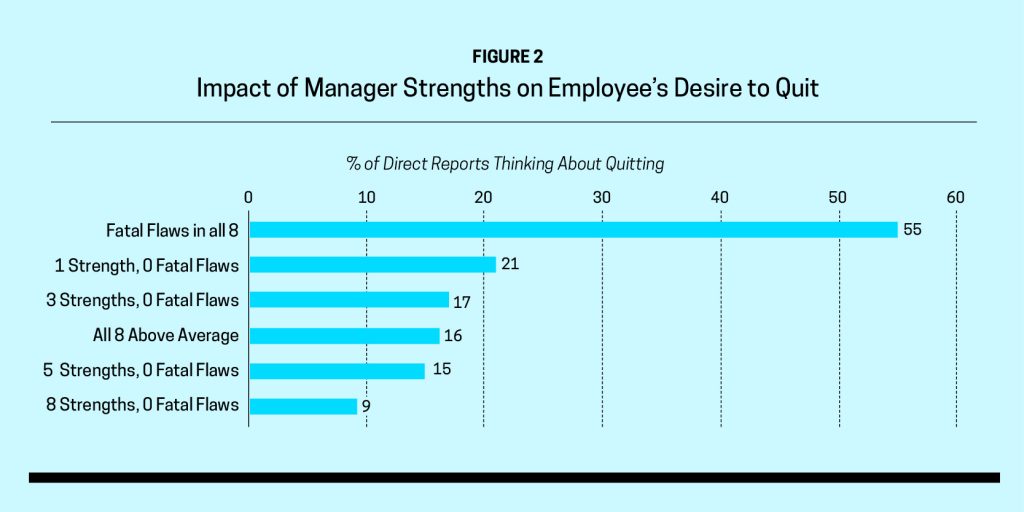Being nice goes a long way toward convincing your employees to stay—but not nearly long enough, the authors’ research shows.
By Jack Zenger and Joe Folkman
You’ve probably heard the cliché that people don’t quit their organization—they quit their boss. Of course, clichés become widespread for a reason. The boss is the personification of the organization and the person who has the strongest influence on a subordinate’s career.
But is there any hard evidence that this oft-quoted saying is actually true? There are many myths in the world of HR. Could a boss alone really cause someone to stay or leave a company? And if the answer is yes, then what exactly is the boss behavior that affects the employee’s choice? Bad decisions? A lack of technical acumen? Behaving like an inept, bumbling oaf? None of the above?
Sign up for the monthly TalentQ Newsletter, an essential roundup of news and insights that will help you make critical talent decisions.
Ask all leaders what they can do to retain employees and the majority will probably say something like, “Be nice.” But we believe it goes beyond that.
When researchers analyzed college professors whose students completed their degrees and went on to be well prepared for life, they discovered something interesting. Students were scored on having:
- Purpose in life (enjoying what they were doing)
- Strong personal relationships
- Economic well-being
- Involvement in their community
- Good physical health to function well on a daily basis
The students with the highest scores were far more likely to have had professors or mentors who provided emotional support to them.
In fact, the single most powerful forces were a professor who made the students excited about learning, a professor who cared about them as people, and a professor who encouraged them with their goals and aspirations. Yet, only 17 percent of graduates of Ivy League universities describe having a professor who cared about them.
It was those professors who showed a specific interest in their students and made a personal connection who had a profound impact on the students’ successful college experiences.
This research illustrates the behaviors that we believe are crucial for leaders who retain and develop their subordinates. We propose a simple three-level analysis of leader behavior that could have the effect of higher retention versus a tendency to leave:
→ Level 1: Offensive behavior that is rude, demeaning, disrespectful, and generally socially unacceptable.
→ Level 2: Nice behavior that is polite, respectful, fair, courteous, and accepting. → Level 3: Caring behavior that shows a genuine interest in the other person, wanting them to flourish and succeed in their work and life.
When you hear the “people quit their boss” cliché, you probably jump to the conclusion that it’s because the boss is behaving at Level 1. But we believe that happens relatively infrequently. Instead, we submit that it’s the behavior at Level 3 that’s mainly responsible for an extremely high level of retention.
To find out for sure, we analyzed 360-degree feedback data for more than 90,000 managers, based on data from more than 467,000 direct reports. On average, each manager was rated by 5.16 direct reports.
We asked each subordinate the extent to which they “rarely thought about quitting their job and going to another organization.” In addition , they evaluated 4 9 specific leadership behaviors.
We then calculated each individual leadership behavior with a Pearson correlation coefficient, correlating each behavior with the “thinking about quitting and going to another organization” item. Finally, we identified the top 20 behaviors with the highest correlation and then factor analyzed them. Here are the eight characteristics that emerged.
8 Traits of Leaders Who Retain Talent
1. Inspires others. People want more than a reasonable job with a steady paycheck. They want to make a difference and do something that’s important. They don’t want a manager who barks orders, tells them what they did wrong, and what to do instead. They want a manager who inspires.
After assessing more than 100,000 leaders on different capabilities, we’ve discovered that the lowest-rated leadership characteristic is the ability to inspire and motivate others. The twist, of course, is that their employees say this is the single most important characteristic they’re looking for in a leader.
Most leaders know how to push, give direction, tell people what to do, and hold others accountable, but they don’t know how to pull or inspire others. Those who do pull well create an atmosphere of energy and enthusiasm, where people want to accomplish difficult goals.
Inspiration starts with a positive emotional connection between a manager and his or her employees. Managers become inspirational by setting a clear vision, challenging team members to accomplish difficult objectives, helping others learn new skills, and creating a positive atmosphere for every member of the team.
2. Communicates powerfully. The number-one complaint coming out of employee surveys is that leaders fail to keep team members informed and up to date. Not so coincidentally, the number-one complaint in marriage counseling is that spouses fail to let each other know important information. The common thread is that these people feel disrespected.
Managers need to prioritize communicating critical information to every team member. Some bosses use this excuse: “I told them, but they didn’t listen.” To which we say: Tell them, tell them, and tell them again. Keep the information flowing, remind team members of deadlines, and congratulate them when they do a good job.
3. Creates a positive team environment. No one likes to work in a place where people fight with one another. But most managers don’t think it’s their job to resolve internal conflicts. Instead, they wait for team members to work out their differences on their own. The reality? Some conflicts just linger on and on, and before long, everyone becomes affected by the lack of resolution.
Managers must insist on playing peacekeeper and creating a positive atmosphere every day. Instilling cooperation across employees and groups will generate an environment that attracts people to the organization instead of repelling them away from it.
4. Has a clear vision and direction. When people feel lost, they feel helpless. But when they’re made clear about where they’re headed and what they need to do to achieve their goals, they’re confident and capable.
The fatal flaw of many managers is that they assume their direct reports know where the team is going, and so they don’t clarify the strategy and direction. But it’s the senior leader’s job to constantly reinforce the overall organizational vision and direction of the organization.
5. Builds positive relationships. When managers send the message that getting results is always more important than individual needs or concerns, team members hear that the results are clearly more crucial than they are.
Managers must be aware of their reports’ individual needs and work hard to balance them with results. To do that, they need to have a comfortable relationship with each team member, and that starts with trust: Do the members trust the boss and believe he has their best interests at heart?
6. Develops others. If people go to an office, work hard, and earn a paycheck every two weeks, that’s a job. On the other hand, if they go to an office, work hard, earn a paycheck every two weeks, and learn something new, that’s a career.
Employees are like cyclists: When they stop moving forward, they fall over. We all thrive on the sense of learning and growing. Thus, managers who look for opportunities to develop their direct reports are much more effective at retaining them.
Leaders can start this process by having discussions with each employee about their career aspirations and expectations. When a new assignment becomes available, the leader shouldn’t give it to someone who’s done something similar several times—she should offer it to someone without the experience, but the drive to learn and succeed. In time, and after providing regular feedback, she will have two skilled people rather than just one.
7. Sets stretch goals. Of course, if the leader asks a team member if they’d like to take on a difficult new assignment, they might turn it down. It’s the leader’s job to get them to accept that goal—because when they accomplish it, something magical happens: Their confidence in their own capabilities goes up, and so does the engagement of every team member. The reason? People want to do hard things. It helps them realize what’s possible.
8. Acts as a role model. Managers need to set the right example for their reports. When they ask team members to put in extra time and effort or cut costs, they need to do the same. If the leader fails to practice what he preaches, his credibility will be destroyed.

The 8 Characteristics in Action
To study the impact of these eight characteristics, we examined data from more than 90,000 leaders with a global database of managers who were assessed by their direct reports. We asked each direct report if they “rarely thought about quitting.” Figure 1 represents the percentages of reports who responded negatively or neutral to that question.
Figure 1: Impact of Manager Effectiveness in the 8 Capabilities

We compiled the results from the overall average of the eight capabilities into an index and divided them into 20 groups, ranging from those with the lowest overall scores to the highest. Note that in the lowest group (5th percentile), 53 percent of the direct reports thought about quitting, while in the highest group (100th percentile), only 10 percent considered leaving. Typically, actual turnover is directly associated with this measure. About half of employees who think about quitting actually quit. As managers look through the list of eight characteristics, it seems like doing all eight exceptionally well would be almost impossible.
In Figure 2, we analyzed managers who had profound strengths (at the 90th percentile) in all eight of the characteristics. While only 3 percent of our population of over 90,000 managers fit the bill, just 9 percent of their direct reports were thinking about quitting.
Figure 2: Impact of Manager Strengths on Employee’s Desire to Quit

On the flip side, of the managers with fatal flaws (10th percentile or lower) in all eight characteristics, 55 percent of their direct reports were thinking about quitting. Managers who were highly skilled in just one of the capabilities, but had none as fatal flaws, were at 21 percent. Managers with three strengths were at 17 percent, and five strengths at 15 percent.
Failing at any one of these characteristics has a significant negative impact. But excelling at one, two, or three can work wonders toward your organization’s ability to keep talent. Of course, the majority of managers may not know if they’re great or terrible at these characteristics.
The only way to accurately measure their effectiveness is by utilizing a valid 360 assessment. It’s your job to provide them with such assessments every two to three years, as well as look for training programs on each individual capability that will help them learn skills like inspiration, communication, collaboration, and development.
After all, your best employees’ futures could be on the line.
Jack Zenger is the cofounder and CEO of Zenger Folkman, a professional services firm providing consulting and leadership development programs for organizational effectiveness initiatives. He is the co-author of seven books on leadership, including Speed—How Leaders Accelerate Successful Execution.
Joe Folkman is the cofounder and president of Zenger Folkman. He is a highly acclaimed keynote speaker at conferences and seminars the world over. His expertise focuses on a variety of subjects related to leadership, feedback, and individual and organizational change.


